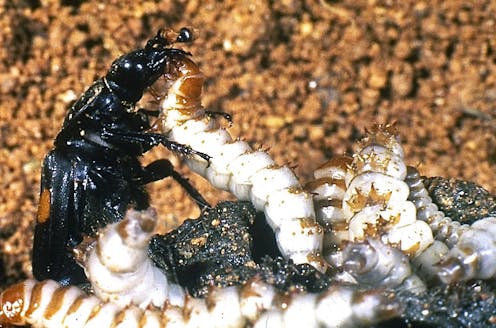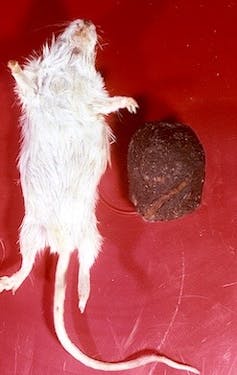Beetle parents manipulate information broadcast from bacteria in a rotting corpse
If you think only humans engage in disinformation, think again. Here is a stunning example of a beetle manipulating the odors emitted from a rotting corpse to keep it hidden from competitors.

Biologists are accustomed to hearing stories of microbes manipulating their host – a fungus that turns ants into suicidal zombies, a protozoan that makes rats seek out cat urine – but there are few examples of hosts turning the tables on their microbes.
My colleagues and I just published a paper that demonstrated that the burying beetle, Nicrophorus orbicollis, found in eastern North America, alters the odors produced by microbes from their subterranean nest to thwart competitors that would steal the beetles’ cache.
A series of unpleasant odors
I have studied burying beetles for over 30 years, at first to understand their parental behavior and physiology, but more recently their role in the community of carrion insects that recycle vital nutrients into the soil. The olfactory environment of burying beetles is one that disgusts many humans but has fascinated me because it is the context in which beetles find their food, advertise for a mate and compete with rivals.
The volatile chemicals that microbes produce as they flourish on a corpse change as the animal decomposes. This changing bouquet of molecules attracts a succession of different insect species. The different mixes of odors represent specific stages of decay that will cue insects that specialize on a fresh corpse or the remains at the end of decomposition, or something in between. Such information may be useful in criminal cases to determine the post-mortem interval.
The focus of a burying beetle nest is a small dead animal that a male-female pair moves underground to prepare as food for its young. Microbes living on a fresh mouse carcass begin to metabolize proteins, emitting sulfurous byproducts that waft in the breeze. These odors attract a flying burying beetle searching for a breeding opportunity.
Working with Paula Philbrick, a microbiologist, I began with field trials to identify the chemicals that burying beetles respond to, so we could discover which ones they might want to manipulate. We tested two chemicals – dimethyl disulfide and dimethyl trisulfide – known to attract carrion insects. These chemicals are used by corpse-mimicking plants in their own manipulation – fooling carrion-seeking flies and beetles into pollinating their putrid flowers.
When we tried these compounds as supplements next to a fresh mouse carcass, however, free-flying burying beetles showed little interest. With our best guess off the mark, we were overwhelmed at the thought of randomly testing each of the more than 500 chemicals associated with a rotting carcass.
Tell us what you know
Rather than playing a chemical guessing game, we decided to take another approach, to see whether the beetles could show us what was important to them.
Our colleagues Sandra Steiger and Johannes Stökl at the University of Bayreuth used a technique called gas chromatography-mass spectroscopy to compare the volatile molecules emitted from carcasses prepared by a pair of N. orbicollis with those emitted from carcasses that had not been touched by beetles.
Surprisingly, two sulfur compounds that were not known to be an important cue for for any insect – methyl thiocyanate and methyl thiolacetate – were both reduced more than twentyfold by the beetles’ labor on the carcass. Why would they do this, and how?
Methyl thiocyanate turns out to be a great cue for burying beetles searching for a carcass. When we went back to the field and placed methyl thiocyanate next to carcasses, over 90% were discovered by burying beetles the first night, compared with a discovery rate of 0% to 20% for fresh carcasses without the chemical supplement.
Methyl thiocyanate appears to be heaven-scent for a beetle searching for that rare, newly deceased mouse or bird somewhere in the forest that is unclaimed by a vertebrate predator or scavenger. Once a carcass is discovered, however, the resident beetles face a problem. The same odors that alerted them could also reveal their carrion prize to competitors. Burying beetles are excellent at detecting and responding to information, but do they control this information as well?
A disinformation campaign
The transformation of a mouse carcass into beetle food is astonishing. After burying the carcass, the pair works day and night to remove the hair, round the carcass into a ball, and apply anal secretions to the exposed skin, dragging their abdomens in a zigzag pattern while circling the carcass.

Scientists used to believe that the resident pair of burying beetles might be sterilizing the carcass, eliminating the microbes that release the telltale odors from the carcass hidden beneath the forest floor. While the secretions do contain antimicrobials, they also contain microbes from the beetles’ gut. The result is a microbial community where the microbes are just as numerous as on an unprepared carcass, but with fewer microbial species than in the normal mix.
This manipulated microbiota emits far less methyl thiocyanate, and surprisingly, much greater amounts of dimethyl trisulfide – the aforementioned compound that is associated with the middle stages of decomposition where competing blowfly larvae make the carcass worthless to a burying beetle.
When we placed dimethyl trisulfide next to a fresh mouse carcass, free-flying beetles were not likely to land, apparently deterred by an odor that indicates a carcass is too far decomposed for breeding burying beetles. A resident pair of beetles makes it difficult for beetle competitors to use odors to find their carcass in two ways: by decreasing chemical attractants and by disinforming rivals by increasing chemical deterrents.
[Understand new developments in science, health and technology, each week. Subscribe to The Conversation’s science newsletter.]
When we took beetle-prepared carcasses from the lab and buried them in the field, they were much less likely to be discovered than similar-aged carcasses that had not been prepared by breeding beetles. Although resident burying beetles will fight to the death if an intruder shows up, the beetles prefer to avoid combat altogether.
Complex adaptations of animals with their microbiota are most often associated with gut microbes that aid host digestion, or cultured microbes that provide food. It makes sense, however, for resource specialists like burying beetles that consistently encounter an external microbiota to evolve similar levels of complexity.
Odors emitted by microbes are essential components of animal communication, social interactions, sexual selection, predator-prey interactions and plant-fungi symbioses. While the control of microbially derived odors by burying beetles might be one of the better examples, the ubiquity of microbes and their chemical products suggest that similar host manipulations will be common, even though humans have been oblivious to these adaptations and their importance.
Stephen Trumbo receives funding from the National Science Foundation and the National Geographic Society.
Read These Next
2 superpowers, 1 playbook: Why Chinese and US bureaucrats think and act alike
The men and women tasked with implementing policy are governed by the same incentives and constraints…
Gazing into the mind’s eye with mice – how neuroscientists are seeing human vision more clearly
It was once believed that mice had relatively poor vision. Turns out mice are far from blind – and…
Epstein’s victims deserve more attention than his ‘client list’
Powerful men connected to Jeffrey Epstein are named, dissected and speculated about. The survivors,…






